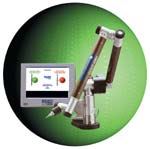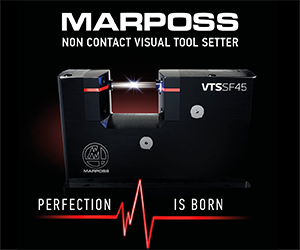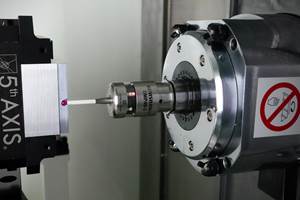On-Demand Inspection Programs
This new software takes the programming of inspection routines, and the overhead that goes with along with it, out of the shop.
Checking parts in-process is viewed by most shops as non-value added time representing a necessary but cost-plus exercise. Manufacturers of gaging equipment realize that while part checking and data gathering are important activities, many of their customers would prefer to devote time, energy and resources to making parts rather than measuring parts.
The general trend in manufacturing is away from dedicated inspection departments in favor of empowering the machinist making the parts to also be responsible for the in-process inspection and data gathering for trend analysis. To that end, manufacturers of inspection and data gathering instruments have tried to create products that are shop floor and machinist friendly.
The dilemma many shops find themselves in is that the sophisticated needs of gathering data combined with more complex workpiece inspection programs are sometimes beyond the machinist’s skill level. At the same time, maintaining specialized employees dedicated to operation of inspection and data gathering instruments is expensive and counter-trend to shops trying to reduce overhead.
On complex workpieces, many of the inspection skills required to accomplish the part inspection reside with the inspection programmer. Faro Technologies, Inc. (Lake Mary, Florida) is proffering a possible alternative that allows shops to get the detailed inspection information required by increasing numbers of customers while using the machinist to obtain the data at the machine tool.
With the introduction of a new software package, which complements its line of portable inspection arms, Faro takes the programming of inspection routines, and the overhead that goes with along with it, out of the shop. The company will take a shop’s workpiece 3D CAD file or 2D print and, for a nominal fee, optimize an inspection program specifically designed for ease of use by the machinist. In effect, it’s on-demand inspection programming. Shops can participate in this service via the Internet, e-mail or overnight carrier. Turn around for this service is within 24 hours.
The new system is called Control Station, with an unabashed nod to the Sony Play Station implying its ease of use. Once an inspection program is created for a workpiece, the machinist uses the Control Station to follow a set of very basic instructions to correctly probe the workpiece. A graphic shows where to probe the workpiece, and the machinist simply points and clicks to accomplish the inspection and data collection. The company claims it’s as easy to use this system as it is to use a go no-go gage.
Once an inspection program is created by Faro, it resides in the Control Station. To revise or modify a program is a matter of sending the revised CAD file or print to Faro via the Internet, e-mail or overnight carrier. A revised program is returned within 24 hours. Moreover, for shops that have the inspection programming skills on staff, the Control Station can be programmed in-house.
Faro is presenting this inspection system as an alternative source for the relatively high skills associated with inspection routine programmers. As shops move toward more in-process gaging and data collection, Faro believes this service offers companies a cost-effective way to reduce fixed costs associated with in-house inspection and data collection.
Related Content
What Should Machinists Know About In-Machine Probing?
In-machine probing doesn’t reach the power of CMMs but can still be useful for pre- and mid-process control, as well as for “rough screening” of parts.
Read MoreChoosing the Correct Gage Type for Groove Inspection
Grooves play a critical functional role for seal rings and retainer rings, so good gaging practices are a must.
Read MoreHow to Choose the Right Cut Off When Measuring Roughness
Measurement results for surface finishing parameters can vary depending on the filter parameter (Lc), also known as the cutoff.
Read More6 Machine Shop Essentials to Stay Competitive
If you want to streamline production and be competitive in the industry, you will need far more than a standard three-axis CNC mill or two-axis CNC lathe and a few measuring tools.
Read MoreRead Next
The Cut Scene: The Finer Details of Large-Format Machining
Small details and features can have an outsized impact on large parts, such as Barbco’s collapsible utility drill head.
Read MoreObscure CNC Features That Can Help (or Hurt) You
You cannot begin to take advantage of an available feature if you do not know it exists. Conversely, you will not know how to avoid CNC features that may be detrimental to your process.
Read More3 Mistakes That Cause CNC Programs to Fail
Despite enhancements to manufacturing technology, there are still issues today that can cause programs to fail. These failures can cause lost time, scrapped parts, damaged machines and even injured operators.
Read More












.png;maxWidth=300;quality=90)















